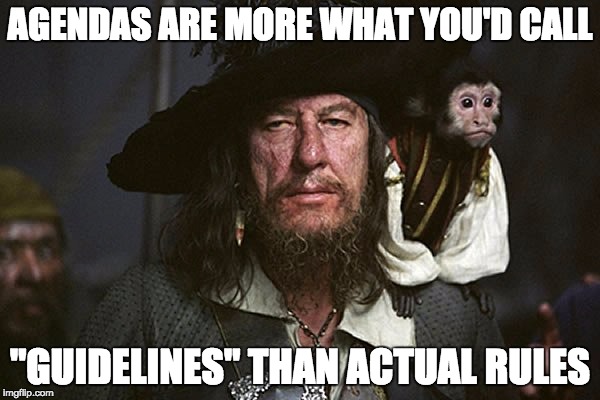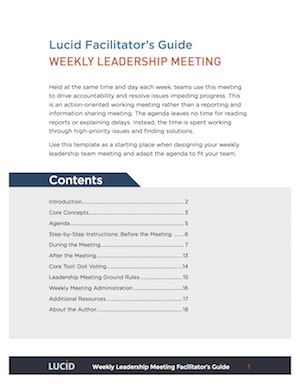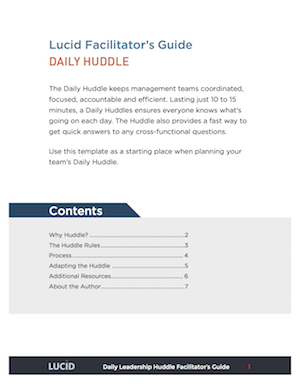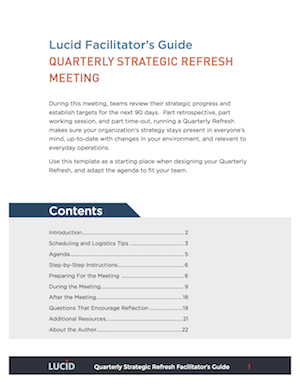The 4 Meeting Agendas that Drive Strategic Execution (Plus Guidebooks for Each)
Contents
- Introduction
- The Dual Cadence of Leadership Meetings
- The Leadership Team Meeting Agenda Templates
- The Operational Management Meetings
Driving Day-to-Day Execution - The Strategic Management Meetings
Driving the Correct Course of Action - How the Leadership Cadence Meetings Work Together
- Next Steps
- Additional Resources
1. Introduction
When we started Lucid Meetings, it wasn’t because we were all excited about meetings.
It was because meetings are the most powerful tool, but also the most neglected, underdeveloped, and misapplied tool, we can use to create a healthy business.
The meetings aren’t the goal. It’s the well-run business that we’re after.
Recently we’ve been exploring the science and theory behind what makes meetings successful.
You can read all about the core function of meetings, the underlying structures that make them work, and the science behind effective decision making in meetings on our blog.
Today, we’re putting all that into practice. This post covers the core meetings that drive effective business management.
2. The Dual Cadence of Leadership Meetings
In his 2017 letter to shareholders, Amazon CEO Jeff Bezos emphasized the importance of accelerating decision making velocity. High-performing leadership teams make decisions rapidly, but not recklessly.
To do so, they need to understand the organization’s overall strategy, so they can make decisions in line with that strategy. They also need to understand the context in which they operate, so their decisions can be implemented.
The leadership team’s job is to make decisions that keep reality aligned with the strategy, and the strategy relevant to the day-to-day reality.
To make this work, they must act at two levels.
- They work on the business, setting strategy, reviewing performance, and safe-keeping the organization’s long term health. This is the strategic level, setting the organization’s aspirations.
- They work in the business, managing teams, monitoring programs, and clearing any roadblocks that get in the way. This is the operational level, grounded in the organization’s reality.
These two levels of focus are deeply linked yet distinct. But the kind of thinking and decision making we need when resolving a logistics problem (operations) is not the kind of thinking we need when evaluating the threat posed by a looming budget shortfall (strategy).
The way a team talks about their work changes the work. If we talk about the big strategic challenges the same way we approach our day-to-day tasks, we waste unnecessary time on the small items and give the big ones short shrift.
This is why it’s important to keep meetings at the operational and strategic levels separate.
The frequency of operational meetings drives the organization’s work momentum.
Leadership teams hold operational meetings often to make sure all the moving parts stay coordinated and problems can be raised and solved quickly.
Frequent operational meetings also ensure that leaders know their reality. They do not let days of change and drift pass between check-ins; they have their fingers on the pulse.
The frequency of strategic meetings drives the organization’s adaptability.
Adjust strategy too often and the organization flails. Wait too long, though, and the organization either stagnates by sticking with a plan that no longer works, or loses coherence as people forget the original strategy and become lost in the everyday minutiae.
This creates the following rules for leadership team meetings:
- Keep operational and strategic meetings separate.
- Hold operational meetings frequently. Weekly at a minimum.
- Hold strategic meetings periodically. Quarterly at a minimum.
- Plan for both. Strategy drives the operational reality, and a grounding in reality keeps the strategy relevant.
3. The Leadership Team Meeting Agenda Templates
The meeting agenda templates and guides outlined below provide a solid foundation for scheduling and running your leadership team’s meeting cadence.
There are 5 meetings in the series.
The Operational Meeting Cadence:
- The Daily Huddle
- The Weekly Leadership Team Meeting
The Strategic Meeting Cadence:
- Annual Strategic Planning
- Quarterly Strategic Refresh
- The Monthly + Anytime Decision Making Meeting
Before you invest the time figuring out if these meeting agenda templates will work for your team, let me address some questions you may have.
What can I expect from these meetings?
Running these meetings will change how you work together, how you feel about your work and how you feel about each other.
Teams that adopt this meeting cadence dedicate time to solving problems and making decisions together, and to using proven methods that result in the best decisions available to them.
This cadence increases transparency and accountability. It demands discipline and encourages constructive debate. It will challenge any team that isn’t confronting their elephants.
These meetings demand more, and deliver more. They’re also way more fun than the traditional soul-sucking staff meeting.
The templates themselves provide a framework for each meeting based on best practices. Each is a good example of how to approach that meeting, adapted from many other good examples.
How important is it that we follow a template exactly?
It isn’t! These templates show one way to run each meeting. The facilitator’s guide also includes tips for adapting each meeting and links to other good examples.
The specific agendas can and should change to match your team’s work requirements, as long as you stick to a regular cadence and ensure each agenda you use achieves the goals for that meeting.
“The process is not the thing. It’s always worth asking, do we own the process or does the process own us?”
That said, before changing an agenda too much, make sure you’re doing so for the right reason. While it may not feel natural at first, every agenda item in these meetings serves a results-oriented purpose.
What do I need to use these templates?
- You need a strategy.
- You need a way of measuring progress.
- You need the discipline to work your strategy.
- Your team needs the ability and willingness to raise and wrestle with hard issues.
Can I use these templates if my team doesn’t have any of that?
Yes, but you’ll have to adjust many of the agendas to find another way of discussing your progress.
If you lack a strategy or a way of measuring progress, we recommend starting there. For a simple soup-to-nuts approach, try Anna O’Byrnes Essential Strategic Planning Toolkit, which walks you through the basics and gets you some measurable goals.
Alternatively, start here and do some shopping: Navigating the Dozens of Different Strategy Options
If the team lacks discipline or constructive dialogue techniques, you can try establishing this meeting cadence as part of how you build that. Expect resistance. Coaching may help.
Books you might also find helpful: Five Dysfunctions of a Team, Crucial Conversations.
My (leadership coach, executive consultant, favorite management book, etc.) says we must (use XYZ technique, measure ABC, etc.) to succeed. Why isn’t that included in your templates?
These templates are designed to work regardless of the specific strategic planning framework or management methodology you use. They provide an effective foundation for teams that don’t have an established meeting practice, and inspiration for teams who need to try something new.
If your practice says you need to varnish the OKRs/Rocks/KPIs, please substitute those anywhere that we talk about scorecards and metrics below. If you need to establish quorum to start a meeting, or open with a prayer, please do.
You are free to color outside the lines.

We’ve prepared facilitator guides for all the meetings described here, and put them together in a single packet that you can download at the end of the post. You can also get the guide for each individual meeting if there’s one that interests you.
Let’s take a look at these meetings in more detail.
4. The Operational Management Meetings
Driving Day-to-Day Execution
There are two meetings in the operational cadence; a short Daily Huddle and a longer weekly team meeting. Both meetings include time spent sharing information, ensuring all leaders work with the latest updates.
Both meetings also devote some time to building inter-team relationships, which helps the leadership group work well together. The main focus for these meetings, however, is problem solving.
The Daily Huddle
The Daily Huddle is a short meeting designed to keep teams in synch and kick the day into gear. You may know it by its other name: the daily stand-up.
This meeting is administrative in nature, covering who’s doing what today, where they’re stuck, and any opportunities they can share.
Desired Outcomes
When run well, a Daily Huddle:
- Saves time by:
- Eliminating a lot of email back-and-forth spent coordinating schedules, hand-offs, etc.
- Answering the “What is Fred up to?” question
- Relieving anxiety caused by uncertainty
- Reveals opportunities when:
- People share info & resources that can help a colleague with an immediate problem
- Teams prevent wasted or duplicative effort
- Someone discovers a chance to learn or participate in a new activity
- Removes obstacles by:
- Getting someone help quickly when blocked
- Re-routing dependent activity
- Re-balancing assignments during crunch times
The Daily Huddle Process
Process: 15 minutes or less. Everyone stands if meeting in person.
When assembled, the group starts an informal go around. Each person shares:
- Plans for the day
- Stuck/Blocks
and possibly - New key decisions or learning
- Confidence on goal completion
Tips for the Huddle
- The Huddle is for identifying obstacles and finding help. The problem solving itself happens after the Huddle between only those people who need to be involved.
- If no one raises any issues for more than a few days in a row, probe harder. There are always issues, and this meeting is about finding them while they’re still small.
- Make sure people share any time when they plan to be unavailable, either due to work or personal commitments. This lets everyone else know to expect delays getting replies and plan accordingly.
For more details, download the facilitator’s guide for running this meeting:
The Weekly Leadership Team Meeting
The Weekly meeting lasts 60 – 90 minutes, and is scheduled for the same time and day each week. In this meeting, teams drive accountability to the plan and identify and resolve issues impeding progress.
While there is some discussion of status and progress, this agenda keeps all that short. Instead, much more time goes directly into problem solving.
It’s a very rewarding way to work, because not only do you stay up-to-date, you see that you’re part of a group that can deal with issues and get stuff done.
Desired Outcomes
When run well, a Weekly Leadership meeting:
- Increases focus on execution by:
- Keeping strategic priorities visible
- Revealing progress (or lack thereof) on goal achievement
- Alerting the team to changes or trends that indicate a bigger problem
- Solves the most important problems fast by:
- Dedicating time to resolving one or two blocking problems every week
- Requiring that the most important issues get addressed, not ignored
- Builds stronger teams and reinforces cultural values by:
- Celebrating victories together
- Sharing personal connections
- Building trust through guided, constructive confrontation
- Fostering a sense of accomplishment
The Weekly Leadership Team Meeting Agenda
Duration: 90 minutes
- Welcome & Review Actions List (5 minutes)
- Schedule Announcements (5 minutes)
- Victories (5 minutes)
- Review the Numbers (5 minutes)
- Quarterly Priorities & Progress (5 minutes)
- Identify Top Issues (5 minutes)
- Tackle Top Issues (50 minutes)
- Review and Confirm Actions List (10 minutes)
Tips for the Weekly Leadership Team Meeting
- The first 5 agenda items reconnect the team with each other, their commitments, and the previously stated goals. This is how you keep accountability to execution front-and-center.
- Save all discussion about missed targets and execution challenges for items 6 and 7. Then, work to prioritize these problems before deciding which 2 or 3 to tackle.
The goal is to solve a few high-importance issues each and every week; don’t lose precious time talking about less important problems.
- An issue or challenge has been addressed when the team decides on a course of action and assigns an owner and due date. To drive follow-up, you’ll review this action list at the close and beginning of every weekly meeting.
For more details, download the facilitator’s guide for running this meeting:
5. The Strategic Management Meetings
Driving the Correct Course of Action
There are three meetings in the strategic cadence: an Annual Strategic Planning meeting, a Quarterly Strategic Refresh, and the Monthly + Anytime Strategy meeting. The three meetings operate at different levels of detail and scope.
- The Annual meeting establishes the high-level strategy for the coming year.
- The Quarterly meeting reviews progress, adjusts the strategic priorities, and sets the specific strategic targets for the coming quarter.
More importantly, it keeps the leadership team connected to the overall strategy, which otherwise starts to get fuzzy and abstract as the year goes on.
- The Monthly + Anytime meeting solves a specific strategic challenge. This meeting can be scheduled any time it’s needed (hence the name) and/or scheduled on a recurring monthly basis.
Annual Strategic Planning
The strategic planning process is where teams paint their grandest visions. It is a time to imagine bright futures and think big thoughts, then wrestle these visions into a form that can be translated into action.
Most groups dedicate at least one to two days for strategic planning every year. In our case, we run strategic planning sessions as a set of short two-hour workshops.
Many larger organizations will spend weeks gathering input before leading a series of planning workshops that then produce annual, 5-year, and even longer-range plans.
What constitutes big or strategic? That’s relative, and because it varies so dramatically from group to group, there is no one-size-fits-all approach to strategic planning.
The design for your Annual Strategic Planning sessions will depend on:
- Whether you have an existing plan, or are starting from scratch
- The stability of your organization and operating environment
- The size and nature of the planning team
- The time you can devote to planning
Our gallery has a sampling of Strategic Planning meeting templates appropriate for those of you who need a place to start.
You can pick and choose the ones you need, or run all of the meetings in this series:
- Vision & Mission
- Organizational Values
- Goals & Strategies
- The Essential Strategic Planning Toolkit (all meetings)
Stable groups might prefer Paul Axtell’s Quick Strategic Refresh.
The Quarterly Strategic Refresh
This meeting requires at least 4 hours to run, but while it’s possible to cover the material in that time, it’s not ideal. Where the annual planning meeting asks everyone to think big picture and long term, the Quarterly meeting requires that teams face their truths.
Are the organization’s actions lined up with the vision? How well have the projections matched reality? What’s going on in the outside world that means your plans need to change?
90 days—or one quarter—is long enough that teams can see results (or lack thereof). It’s also long enough that it’s become hard for everyone to keep the spirit of the original strategy fresh in their minds.
Quarterly Strategy meetings often raise questions about what the original strategy actually meant, as differences have had time to grow.
When possible, we recommend scheduling a 1 to 2 day off-site for this meeting. Moving off site helps the group step away from the day-to-day operations, and provides better opportunities for reinforcing the relationships you need in place in order to work through challenging questions.
Desired Outcomes
When run well, a Quarterly Strategic Refresh meeting:
- Keeps the strategic plan relevant and fresh by:
- Revisiting the plan and clarifying definitions
- Challenging assumptions
- Reviewing recent events for impact to the overall strategy
- Establishes clear benchmarks for the next 90 days by:
- Reviewing past performance against targets so new reality-based targets can be set
- Documenting the specific programs and targets for every functional group in the coming 90 days
- Strengthens team alignment and relationships by:
- Celebrating victories and accomplishments
- Sharing key learnings, goals and challenges
- Working together to establish a 90 day plan to which the whole team can commit
The Quarterly Strategic Meeting Agenda
This is an outline only. You’ll find more detail in the facilitator’s guide.
- Welcome. Connect.
- Past quarter highlights
- Key learnings
- Goals for the day
- Review Agenda
- State of the Strategy
- Review the overall strategy
- Review quarterly progress
- Review the open issues list
- Discuss
- What went well and why?
- What didn’t go well and why?
- What’s changed in our overall context in the past 90 days?
- What do we need to adjust in our approach for next quarter?
Checkpoint and LONG Break
- Reconnect
One-word phrase: How are you feeling about tackling the planning in front of us? - Plan the Next Quarter
- What do we specifically need to start, stop, and continue?
- Define metrics: New quarterly targets, KPIs, etc
- Define action plan: Who, What, When
- Confirm the Plan
- Review Parking Lot
- Confirm plans
- Identify key messages to be shared with stakeholders
- Close
- Anything else that needs to be said?
- Offer appreciations
- One-phrase review
Tips for the Quarterly Strategic Meeting
- Take breaks every 90 minutes or so. This gives people time to talk in small groups and think through any hard issues. It also helps everyone stay more focused in the meeting, giving them a chance to check in on the day-to-day activity.
- Keep the discussion structured but not rigid. You’re a team of colleagues working together to drive your business – this should feel more like an intense meeting and less like an over-planned workshop.
- If you have the time, add more to the agenda. The quarterly meeting can be a good time for the leadership team to evaluate key personnel, for example. A shared meal or two creates opportunities for deeper discussion and relationships.
For more details, download the facilitator’s guide for running this meeting:
Does all that look like too much? Paul’s Strategic Refresh is a shorter meeting that can be used as a Quarterly Refresh for groups that don’t want or need to go this deep.
The Monthly + Anytime Decision Making Meeting
Last but not least, the Monthly + Anytime meeting dedicates time to deeply investigating and addressing a specific strategic challenge. The process follows best practices for problem solving and decision making with a group.
We call this an “anytime” meeting because it should be scheduled any time a serious strategic issue comes up. That said, we’ve included it in the leadership cadence because many organizations find it useful to put one of these meetings on the calendar every month – before a problem occurs.
Why schedule a problem solving meeting before you know you have a problem? Three reasons:
- This is a longer meeting involving key decision makers in your organization. It can be very hard to get time on their calendar on short notice.
- Dedicating this time every month for longer problem-solving discussions keeps them from bogging down the weekly meeting.
Without a monthly time reserved, it’s tempting to tackle strategic issues during the weekly meeting, which sabotages the tactical nature of that meeting and leads to rushed and/or sloppy decision making.
With the Monthly meeting safely on the calendar, teams can defer the conversation and feel confident that the big discussion they need will happen.
- There are always strategic challenges! New opportunities, new threats, hard decisions: c’mon! You know this stuff will come up, so you might as well have a plan for dealing with it.
Desired Outcomes
When run well, a Monthly + Anytime Strategic meeting:
- Gets decisions made by:
- Establishing a clear understanding of the issue and goals
- Driving healthy debate between informed options
- Documenting the decision
- Secures team commitment to the decision by:
- Setting clear expectations about the decision authority and criteria
- Using an inclusive process to hear from all voices
- Defining next steps with identified owners and due dates
The Monthly + Anytime Strategic Meeting
- Welcome
- Greetings
- Confirm purpose
- Clarify the decision making process
- Present the Decision Challenge
- Debate & Discuss Options
- Decide and Commit
- Define Next Steps
- Set next steps: who, what, when
- Determine cascading messages: who needs to know what?
- Set a date to review the decision outcome
- Close
- Final review: anything that needs to be answered, said, or addressed?
- Appreciations
- Meeting feedback
Tips for the Monthly + Anytime Strategic Meeting
- You can tackle more than one topic if they’re not too large. This process is designed to tackle a single strategic challenge. If you want to tackle more than one topic, you will need to repeat steps 2 through 5 for each. Anticipate at least 30 minutes for each smaller decision.
- Preparation is required. The team needs good information to make good decisions, which means someone has to do the research first.
- Decide on the appropriate decision making process in advance. Learn more about that in our guide to Making Decisions in Meetings.
For more details, download the facilitator’s guide for running this meeting:
6. How the Leadership Cadence Meetings Work Together
Now that we’ve looked at the individual meetings in the series, let’s see how they all work together to keep an organization humming.
A 90 (ok, 94) Day Schedule
Here’s one way you might plan out this cadence for a quarter.
Week 1:
- Days 1-2: All day Annual Strategic Planning (16 hours)
Your team sets the strategy, annual priorities and target metrics for the first quarter. - Day 3: Daily Huddles begin.
Huddles take 10 minutes. The Huddle is a short meeting with verbal reports, so no one needs any extra prep time.
Week 2 – 13:
- Monday mornings: Weekly Leadership meeting (90 minutes)
Before this meeting, everyone needs to update their metrics, open action items, and come ready to discuss any issues they’re facing. Each person spends up to 20 minutes prepping for this meeting.In the first week, there isn’t much to report. As the weeks go by, though, it gets easier to see which parts of the plan aren’t working out as planned. Some issues are straightforward, so the team knocks those out in the weekly meeting. Others are harder, so they get put on the list for the monthly strategic meeting.
- Tuesday – Friday: Huddle (10 minutes)
Held every day except Monday, when the team already spends 90 minutes together. After a few weeks of this regular check-in, you start to notice patterns. Maybe you discover that the different groups aren’t working at the same pace, creating constant delays. Maybe some departments are crushing it and others always seem to be struggling. No big emergencies, but you’ve got a feel for the pulse and a sense for where you need to make adjustments in how the organization operates.
Weeks 4 and 9:
- Thursday afternoon: Monthly Decision Making Meeting (90 minutes)
In one of the Monday meetings, your team brought up a problem or an opportunity that couldn’t be resolved in 30 minutes. So in your Weekly Leadership meeting, you assigned one or two people to conduct more research and make recommendations.
The leaders researching the challenge dug into the details, and sent a report to everyone outlining the facts. They also worked with their teams and colleagues to find at least 3 viable options to decide between. Depending on the challenge, this could have taken hours or days – time spent making sure the team makes the best possible decision they can.
Not everyone on the leadership team needs to attend the Monthly Strategic meeting. If this month’s challenge comes from the marketing department, and the safety lead doesn’t really have any skin in that game, she may choose to bow out. Those who do participate make sure they’ve read the report in advance and come prepared, each spending up to an hour getting ready for the meeting.
At the end of the Monthly Strategic meeting, the team has a decision and a set of new action items to add to the list they’ll review during next Monday’s Weekly Leadership meeting.
Week 14:
- Monday afternoon and Tuesday morning: Quarterly Strategic Refresh (8 hours)
Week 14 and it’s been 90 days since your team set the strategic plan. With the Daily Huddles, you’ve learned the day-to-day rhythm of how work flows through the organization. The Weekly Leadership meetings have shown where the original plan is working well, and where it’s not. You’ve been deeply involved in all the small, important work of execution.
Finally, during the Monthly Strategic meeting you’ve learned how to critically examine big issues and refine specific strategies.
Now it’s time to pull back and look at the big picture. Given everything you’ve learned about each other, the organization, and the work at hand, what needs adjustment? What should the targets for this coming quarter be? Which big challenges do you still need to dig into? You’ll dedicate Monday afternoon and Tuesday morning to refining the plan, enjoying a nice dinner in between.
After the Quarterly Strategic meeting, one person will make sure that the new targets are all set up so you can start reviewing them in next Monday’s Leadership meeting.
… and repeat.
A 10% Time Investment That Drives Your Business
I did the math, and here’s a surprise. While the plan above looks and sounds like a ton of time spent in meetings, it represents just 10% of a full-time employee’s available time.
Actually, just under 10%; 4.9% spent in operational meetings (26.5 hours) and 5% in strategy sessions (27 hours) over the course of 13 weeks and 2 days (536 hours).
In reality, some people will spend more time than this. Anyone researching an issue for the Monthly Strategic meeting needs to spend considerable time there. Everyone needs to add another hour or two over the course of the quarter to prepare for the Weekly meetings by updating their metrics and action items.
And the Quarterly meeting requires yet another hour or two of prep from everyone involved. Annual Planning also takes more time – but far less in years 2 and 3 than it did before you put this cadence in place, because you’re building and refining instead of starting from scratch.
This is an incredibly efficient approach to managing a business.
Personally, I’ve worked in environments without this structure where we spent WAY more time talking about our progress, lack of progress, and strategic challenges – rarely ever deciding on ways to solve our problems.
We just kept talking about them and pointing fingers and bemoaning how impossible it all was because we didn’t know what else to do.
I’m happy to have learned a better way.
7. Next Steps
Lucid Meetings is a system designed to support a meeting cadence like this.
If you use or want to try out this pattern with your team, you should give our software a try. We have a template for each meeting described here that will make your setup, action item tracking, and meeting management a breeze.
You can also download our facilitator’s guides to learn how to lead these meetings and run them however you see fit.
We have a guide for each meeting, and a packet that includes the guides to all the meeting templates mentioned in this post. Expect to kill some trees if you want to print it out; it’s hefty stuff.
Finally, we developed this meeting cadence after lots of research and experimentation. We are building on the work of the many others who have gone before.
Our choices may or may not be right for you, so I’ve listed a selection of additional resources below. There you’ll find lots of variations on this theme, and perhaps some alternate techniques that better fit your crew.
As always, comments, questions, and corrections are very welcome. Now go run a magnificent organization!
General FAQ
What is ‘The Dual Cadence’ of Leadership Meetings?
Leadership Teams must act at two levels.
- They work on the business, setting strategy, reviewing performance, and safe-keeping the organization’s long term health. This is the strategic level, setting the organization’s aspirations.
- They work in the business, managing teams, monitoring programs, and clearing any roadblocks that get in the way. This is the operational level, grounded in the organization’s reality.
What are the five critical Leadership Team meetings?
- The Daily Huddle (an operational meeting)
- The Weekly Leadership Team Meeting (an operational meeting)
- Annual Strategic Planning (a strategic meeting)
- Quarterly Strategic Refresh (a strategic meeting)
- The Monthly + Anytime Decision Making Meeting (a strategic and/or operational meeting)
What can I expect from these Leadership Team meetings?
Running these meetings will change how you work together, how you feel about your work and how you feel about each other.
Teams that adopt this meeting cadence dedicate time to solving problems and making decisions together, and to using proven methods that result in the best decisions available to them.
How important is it that we follow your example template exactly?
It isn’t! These templates show one way to run each meeting. The facilitator’s guide also includes tips for adapting each meeting and links to other good examples.
The specific agendas can and should change to match your team’s work requirements, as long as you stick to a regular cadence and ensure each agenda you use achieves the goals for that meeting.
What do I need in place before using your example templates?
- You need a strategy.
- You need a way of measuring progress.
- You need the discipline to work your strategy.
- Your team needs the ability and willingness to raise and wrestle with hard issues.
Can I use your example templates if my team doesn’t have discipline?
Yes, but you’ll have to adjust many of the agendas to find another way of discussing your progress.
Why don’t your example templates include my Leadership coach’s favorite techniques?
These templates are designed to work regardless of the specific strategic planning framework or management methodology you use. They provide an effective foundation for teams that don’t have an established meeting practice, and inspiration for teams who need to try something new.
How do the Leadership Cadence Meetings work together?
You’ll want to develop your own Meeting Flow Model that connects all the dots. We’ve provided a great starting point for you and you should probably begin with that. But in the end you’ll want to make this your own ⏼ and we heartily encourage that!
8. Additional Resources
Books
Business Management
- Patrick Lencioni
“Death by Meeting: A Leadership Fable…About Solving the Most Painful Problem in Business“ - Geno Wickman, “Traction: Get a Grip on Your Business“
- Verne Harnish , “Scaling Up: How a Few Companies Make It…and Why the Rest Don’t (Rockefeller Habits 2.0)“
- Peter Drucker, “The Effective Executive: The Definitive Guide to Getting the Right Things Done“
Meeting Design
- Dick and Emily Axelrod, “Let’s Stop Meeting Like This“
- Rick Lent, “Leading Great Meetings: How to Structure Yours for Success“
- Paul Axtell, “Meetings Matter: 8 Powerful Strategies for Remarkable Conversations“
Web
Research
Articles and Blog Posts
- The Art of the Huddle
- Counter-Intuitive Leadership: Building Teams That Can (Accurately) Predict the Future (about the Weekly meeting)
- The Importance Of Management Meeting Agendas (Before, During, & After)
- Recognize and Plan for Results – The Quarterly Meeting
- Effective Quarterly Meeting Planning
- How to Make a Big Impact at Your Next Quarterly Meeting
- The Big Lie of Strategic Planning
- Five Steps to a Strategic Plan
- Video: Dave Snowden – How leaders change culture through small actions








